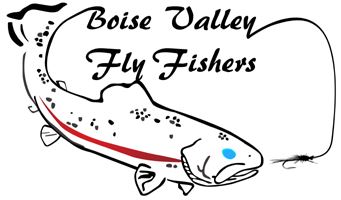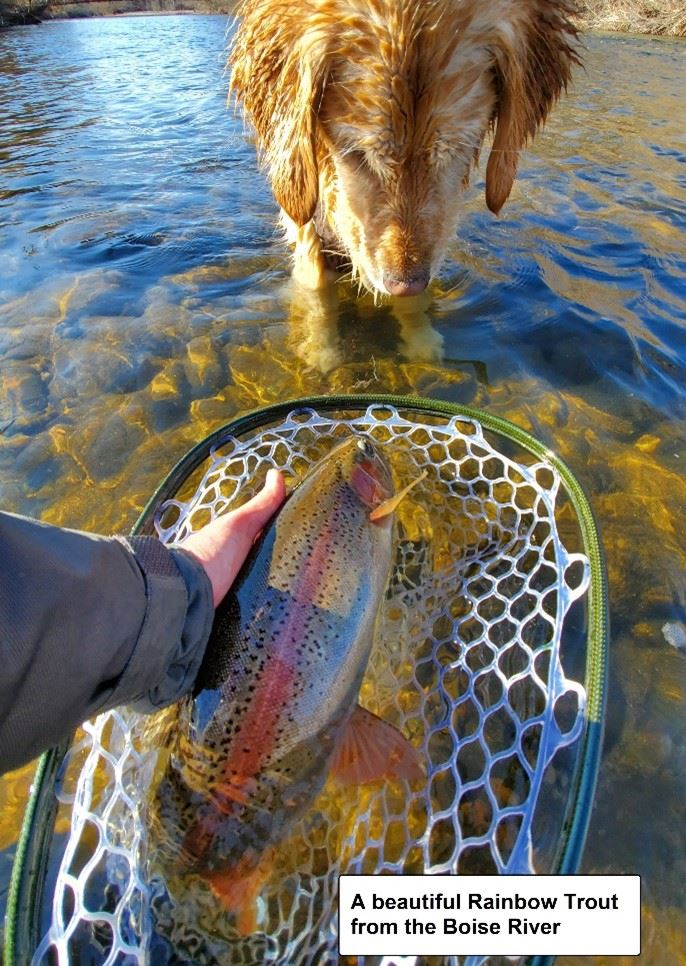 The Lower Boise River (Boise River) is a unique resource that makes the Treasure Valley a special place to live, play and visit. The trout population is better now than it ever has been thanks to the many organizations that are actively working to improve trout habitat on the Boise River, including Idaho Fish and Game (IDFG), Boise Valley Fly Fishers (BVFF), Trout Unlimited (TU), the Boise River Enhancement Network (BREN) and the Intermountain Bird Observatory (IBO). Together, these organizations are protecting the river and helping improve wild trout reproduction, resulting in better fishing for all of us.
The Lower Boise River (Boise River) is a unique resource that makes the Treasure Valley a special place to live, play and visit. The trout population is better now than it ever has been thanks to the many organizations that are actively working to improve trout habitat on the Boise River, including Idaho Fish and Game (IDFG), Boise Valley Fly Fishers (BVFF), Trout Unlimited (TU), the Boise River Enhancement Network (BREN) and the Intermountain Bird Observatory (IBO). Together, these organizations are protecting the river and helping improve wild trout reproduction, resulting in better fishing for all of us.
The river below Lucky Peak Dam is considered a Tailwater fishery because the outflows from Lucky Peak come from the bottom of the dam, which helps keep water cool during the summer. IDFG regularly stocks the main Boise river with rainbow trout and brown trout (trout stocked now are called “Triploids” and are sterile). IDFG historical stocking records show that in the last three years significantly more rainbow trout have been stocked than brown trout, with most of the trout being stocked from Middleton up to Barber Park.
In addition to stocked trout, the Boise River has a good population of wild reproducing rainbow and brown trout, as well as some remaining native redband trout. The river could have more wild trout if it had better trout spawning and rearing habitat. Here is a great video presentation by Idaho Fish and Game on the Fish of the Boise River that gives an overview of the history of the river, its trout population, and factors that are important to help improve the fishery.
Spawning Size Gravels
The primary limiting factor for wild trout spawning is availability of smaller gravels. This is because the higher spring flows every year since Lucky Peak was built in 1955 have washed most of the smaller sized gravel downstream and newer gravels from up-river are blocked from refreshing the river because of the series of dams above. One way to replace those lost gravels is through a gravel augmentation where spawning sized round gravels (1/2” to 2” in size) are added to the river to improve trout spawning habitat. Side channels are the best area to do gravel augmentations both because they are the preferred location for trout to spawn and gravel is less likely to wash away because the side channels have less water velocity. The Ted Trueblood chapter of Trout Unlimited has done gravel augmentations up in the Park Center reach of the river in the side channels at Warm Springs (in 2005) and Heron Creek (in 2009), and since then the IDFG shoreline fry surveys have found that the best population of “baby” trout fry are in those areas, which is strong feedback that their gravel augmentations are working.
BVFF was inspired by TU’s success and wanted to do additional gravel augmentations on the Boise River to continue to improve trout spawning habitat. BVFF consulted with IDFG and fish habitat restoration experts at BioAnalysts to identify a suitable side channel on the Boise River in Garden City. Prior to the gravel augmentation this section of the river was considered to have a low density of trout fry, compared to the upstream areas where TU did their gravel augmentations. In 2019 BVFF obtained the needed stream alteration permits and added 12 cubic yards of gravel to three areas in the “BVFF Side Channel” that runs around New Dry Creek Diversion on the south side of the river, between Glenwood Bridge and the head of Eagle Island. Since then, we have seen a significant increase in both rainbow and brown trout spawning. Rainbow trout spawn in the Spring and they preferred to make their redds in the upper section of the side channel, while brown trout spawn in the Fall and have liked the slower water in the middle and lower sections of the side channel.
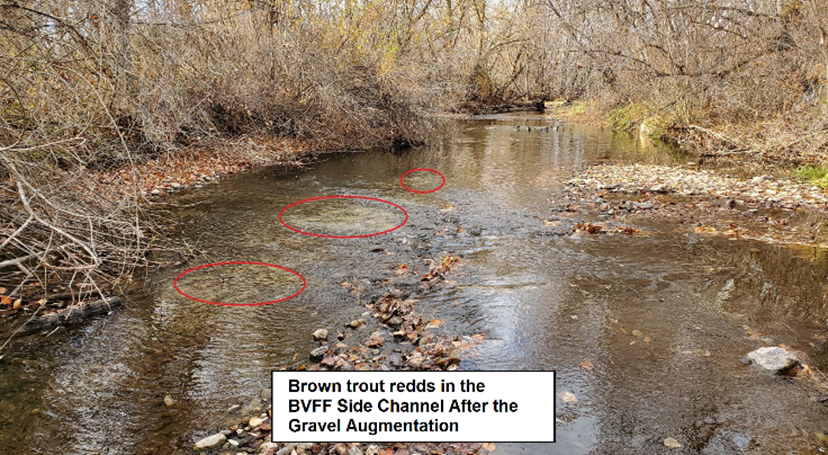
Last Fall (Nov 2022) we were able to accompany IDFG on one of their Shoreline Fry Surveys that included the BVFF Side Channel. We sampled 6 sites on the main Boise River from Willow Lane down to the BVFF Side Channel and 3 sites in the BVFF Side Channel. We netted approximately 20 trout fry at the 6 sites on the Main Boise river and 84 trout fry in the BVFF Side Channel—good evidence that the gravel augmentation is helping improve the number of trout fry. It is exciting to see this “Field of Dreams” scenario playing out, and we anticipate we will see improvements in the adult trout population over the coming years.
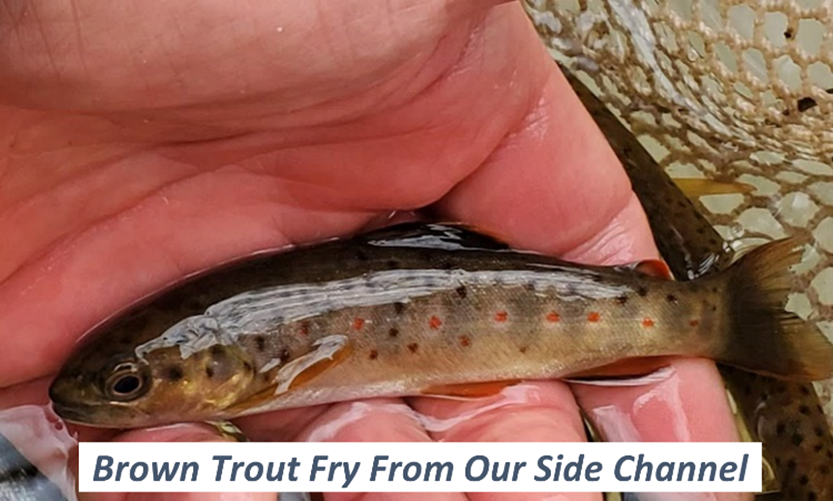
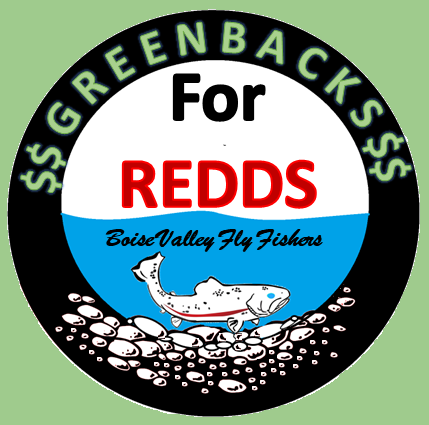 The gravel we added in 2019 is slowly shifting downstream in the BVFF Side Channel and Mother Nature is putting it into locations that are suitable for trout to spawn. We have applied for another stream alteration permit and plan to refresh gravel in the side channel this winter so the rainbow trout have fresh gravel for spawning and Mother Nature has more building materials to work with during the next spring runoff. The gravel refresh is estimated to cost around $1,200. We are raising money to fund the gravel refresh by selling “Greenbacks for Redds”. If you are interested in helping fund the donation, please buy a Greenback at the BVFF Online Store.
The gravel we added in 2019 is slowly shifting downstream in the BVFF Side Channel and Mother Nature is putting it into locations that are suitable for trout to spawn. We have applied for another stream alteration permit and plan to refresh gravel in the side channel this winter so the rainbow trout have fresh gravel for spawning and Mother Nature has more building materials to work with during the next spring runoff. The gravel refresh is estimated to cost around $1,200. We are raising money to fund the gravel refresh by selling “Greenbacks for Redds”. If you are interested in helping fund the donation, please buy a Greenback at the BVFF Online Store.
Woody Cover
Another issue that limits the wild trout population is the lack of good woody debris that helps protect young trout fry from predators as well as provide shade and habitat for aquatic insects. And although Gravel Augmentations are much “sexier”, improving woody cover is just as important to helping those fry survive their first year. But because the Boise River flows through an urban area, much of the natural downed trees are removed to reduce flood risks and improve public safety for recreational floating. This results in less cover for young trout and a lower rate of survival. IDFG would like to see more woody debris in the Boise River and in 2016 they did a project at Barber Park to improve aquatic habitat by adding engineered logjams and boulders. These logjams and boulders created sheltered areas for fish to rest, hide from predators and feed on bugs.
As a part of BVFF’s Gravel Augmentation project in 2019 we worked with Boise Flood District 10 to retain downed trees in the side channel that would have normally been removed. This woody cover gave trout fry a place to hide after hatching out of the nests/redds resulting in a higher survival rate. The value of this woody cover was evident last Fall when IDFG did their Shoreline Fry Survey as the majority of the juvenile trout found in the BVFF Side Channel were tucked underneath the woody cover. Here is a short video segment of the IDFG Shoreline Fry Survey in the BVFF Side Channel—note how the trout fry were hiding in the downed tree along the bank. FrySurveyVideo.mp4
In recent years the Boise Flood District has been working to improve their management of tree hazards along the Boise River Corridor to keep trees that are leaning over the river and providing shade. BVFF has continued partnering with Boise Flood District 10 and IDFG to look for opportunities to improve woody debris in the river where it is safe to do so. Side channels are one of the best places to do this because downed trees there are not a danger to floaters and are less likely to come loose and float away. Downed trees in side channels also provide high value cover for trout fry that hatched from trout redds in the side channel. Bank stabilization and plantings by BREN, TU, the City of Boise, and others are also helping improving woody cover on the Boise River.
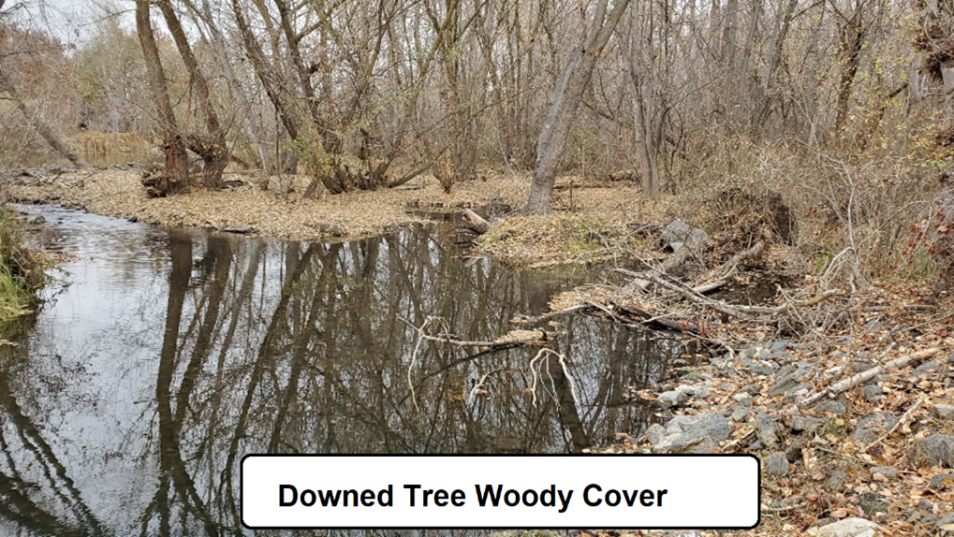
Side Channel Habitat
Side channels are the preferred spawning location for trout because of reduced velocities and a naturally higher amount of spawning sized gravels that are pulled from the banks. Side channels are considered the best rearing locations because they offer protection for young trout from higher velocity flows and have a higher amount of natural woody cover. Side channels that flow during both the summer and the winter are especially important, however one systemic issue with rivers below dams is the loss of side channel habit. Essentially over time the river fills in its side channels and becomes one large “channelized ditch”. This occurs because the high water flows (such as from Snowmageddon) move large cobble into the mouths of side channels but river flows on years after that are artificially restricted by Lucky Peak which keeps the river from reestablishing flows into those side channels.

Two side channels of the Lower Boise River that were lost from the 2017 Snowmageddon high runoff flows are behind the Les Bois racetrack. These two side channels represent a mile of premium year-round trout spawning and rearing habitat but now do not flow during the fall and winter seasons. BVFF is working with IDFG on a plan to “un-plug” the entry to these two Les Bois side channels so they will again flow in fall and winter, which will open them back up for brown trout spawning and over-winter protection for young rainbow and brown trout. Stay tuned for more information as this project progresses over the next few years.
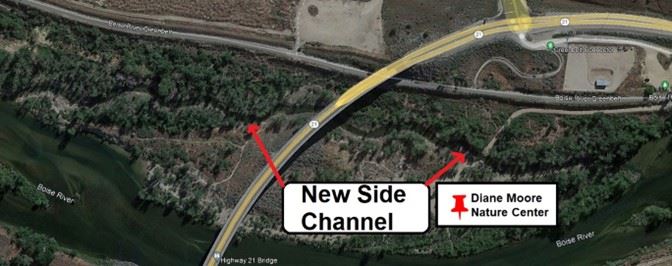
One side channel that has been reopened recently is at the new Diane Moore Nature Center. The project, lead by the Intermountain Bird Observatory, worked through the permitting to restore a historic side channel and rebuilt it, including adding spawning size gravel for trout and copious amounts of woody cover for trout fry protection. BVFF partnered with the Intermountain Bird Observatory on trout habitat signs that have been installed along the restored side channel, as well as building a new angler access at the site. BVFF is very excited to be working up at the Diane Moore Nature Center and we plan to stay involved helping protect and improve trout habitat there. One of the Trout Habitat signs we installed and a photo taken at the side channel this summer are shown below. It is rewarding to see the small fish hiding in the woody cover—just like the Trout Habitat sign depicts!
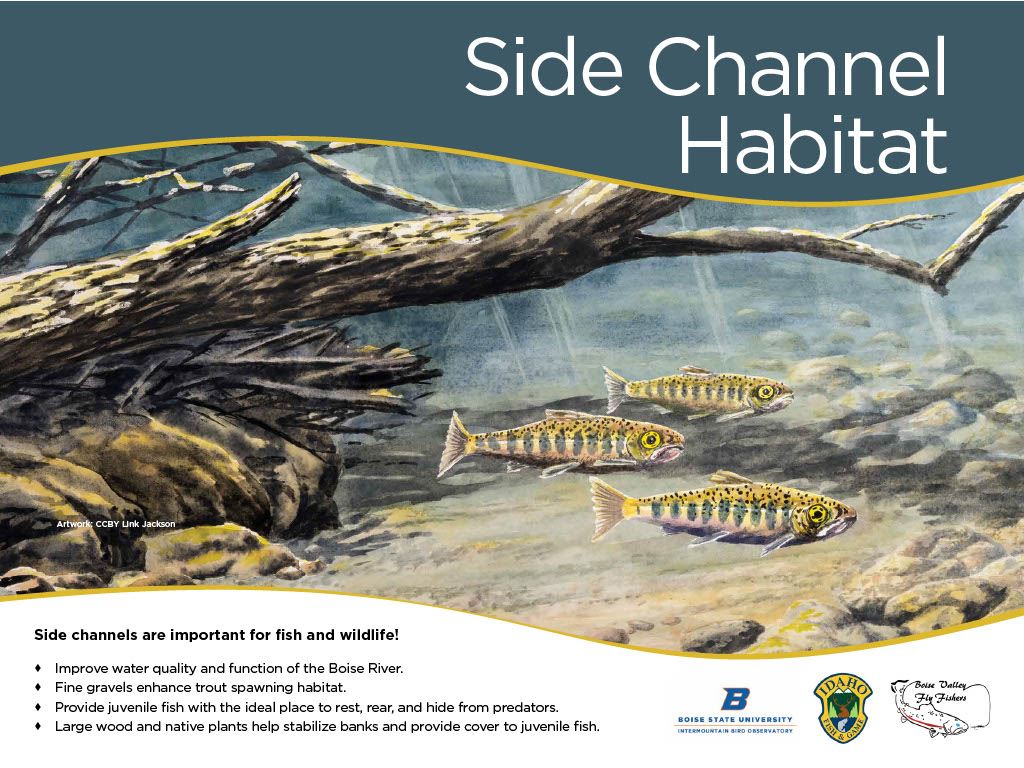
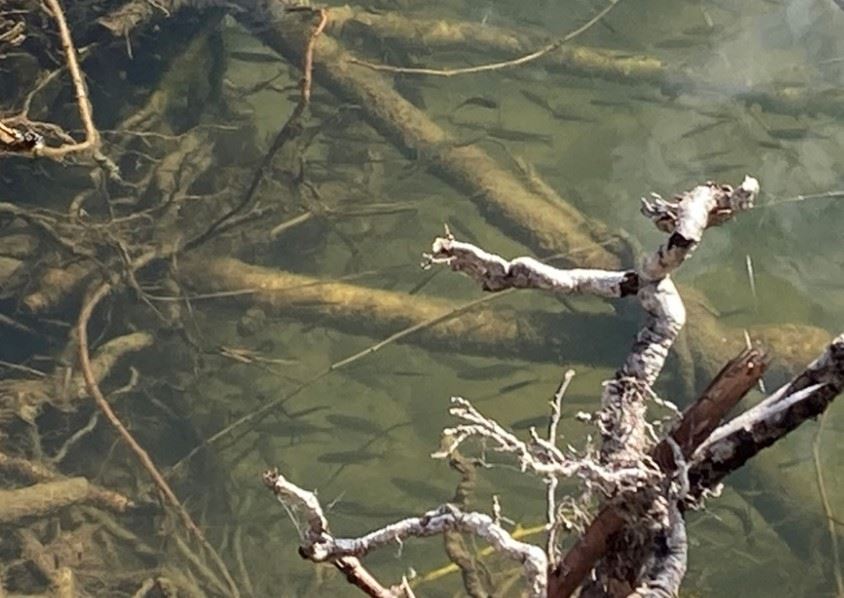
Trout Redd Protection
Rainbow trout spawn in the higher flows of spring and brown trout spawn in the lower flows of fall. Because of the lower flows the brown trout redds (nests) are more vulnerable to being trampled by unknowing anglers or equipment in the river doing irrigation or flood control work. BVFF has partnered with IDFG and Boise Flood District 10 to map the location of Brown Trout Redds so the flood district can avoid them during their annual winter maintenance activities. Mapping Brown Trout redds has been a great opportunity learn about trout spawning habitat while improving the Brown Trout reproductive potential in the Boise River. Angler education is also important, and many fishermen do not know what a trout redd looks like. BVFF has been working on angler “Redducation” so they can recognize and avoid redds in the Boise River while out fishing. BVFF has made Redducation the focus at their Fly Fishing Expo booth the last two years and are planning to attend the Boise Sportsman Show in March to increase the impact of this message. Here is a short Redducational video we did on the Boise River.
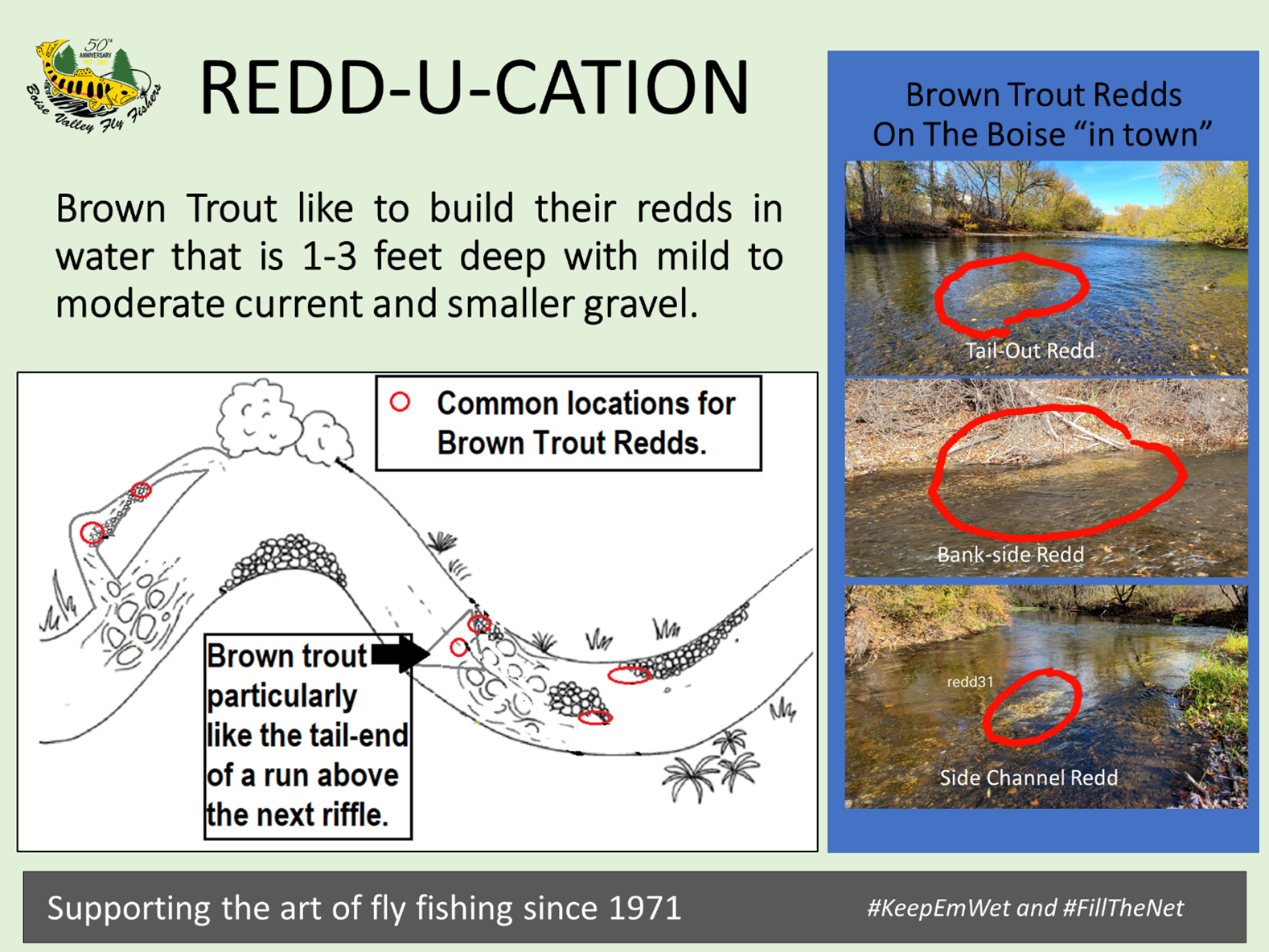
Minimum Winter Flows
Winter water flows are important to a healthy trout population, especially trout fry going into their first winter. Before the mid 1980s the Boise River would often drop to 50cfs to 100cfs during the winter, which was very hard on the overwinter survival of trout and whitefish. Over time IDFG has worked to improve the winter flows on the Boise River, and typical winter flows today are 240cfs which has dramatically improved the health of the river and the trout population. Lucky Peak is unique in that IDFG has a storage water right for streamflow maintenance. Currently IDFG does not fully use all their water right and they are investigating raising winter flows to 300cfs or even 350cfs, which would increase the number of side channels that have water in the winter and give trout access to more spawning and rearing habitat.
The split of water on the Boise River between the north and south channels around Eagle Island varies year to year, and although the main Boise River had more water the Fall of 2022 than it did in 2021, the flows in the north channel were down by 25% due to changes at the head of Eagle Island made for irrigation. In our fall 2022 Brown Trout Redd Survey we noticed fewer redds in the north channel than the year before. Our observation was that some of the spawning areas did not have sufficient water depth for brown trout to make their redds due to the lower water levels. IDFG is very interested in tracking brown trout redd trends and we will continue to share our yearly brown trout redd location information with them to help show the need for higher winter flows on the Boise River.
A Winning Recipe
When you put together spawning gravel and woody cover in a side channel that flows year-round, you have a winning recipe for improving the trout population. The spawning gravel gives you more “trout seeds” and the woody cover increases the yield of the “trout crop” that is available at the end of the year. And having an overwinter side channel helps that crop of young trout make it through their first winter and into adulthood. The BVFF Side Channel has all three of these winning ingredients, and we will be continuing to look for other side channels in the Boise River where we can apply the same approach.

References For More Information
- IDFG Boise River Aquatic Habitat Project
- BREN Boise River Plan
- IDFG 2019 SW Region FISHERIES MANAGEMENT ANNUAL REPORT
- Boise River Winter Flows

